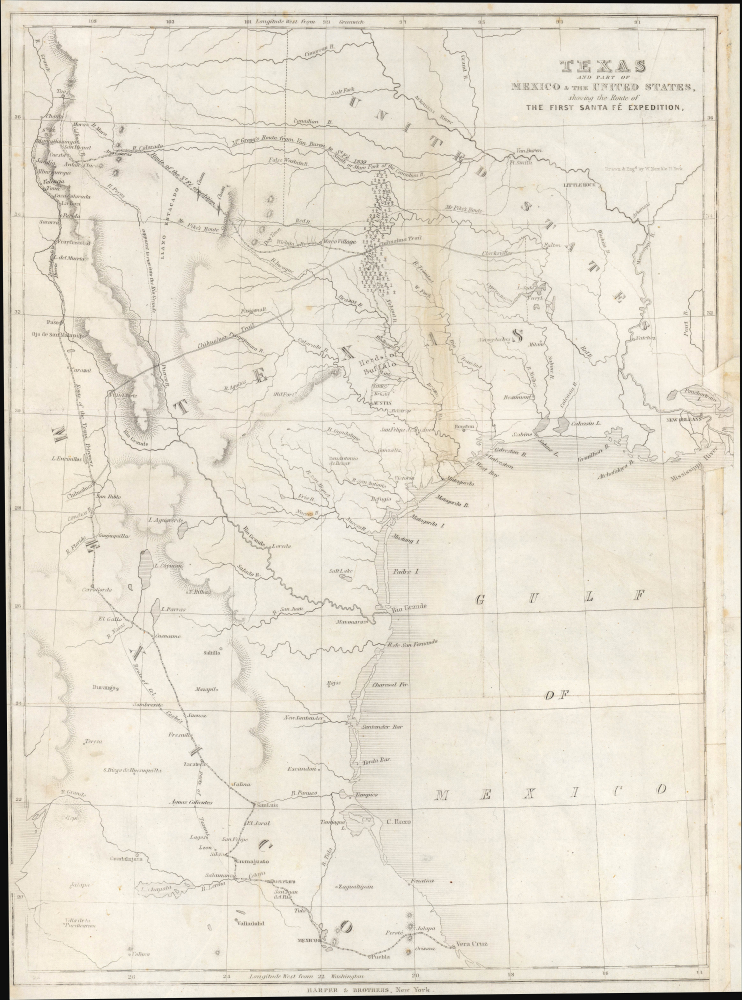1844 Kemble Map of the Republic of Texas and Mexico, Texan Santa Fe Expedition
TexasSantaFeExp-kemble-1844
Title
1844 (undated) 16 x 12 in (40.64 x 30.48 cm) 1 : 5400000
Description
A Closer Look
Coverage includes the Republic of Texas, a large portion of Mexico, including New Mexico, and a portion of the United States (Arkansas, Louisiana, Mississippi, Indian Territory). Borders are eschewed, except for where they do not follow rivers, reflecting both the uncertainty and porousness of borders at the time. In addition to rivers, areas of elevation, forests, lakes, and other topographic features are included and labeled. Settlements, including forts, are noted throughout, as are the route of the 1841 Texan expedition, regular trail routes, and the paths taken by earlier explorers and expeditions.The Texan Santa Fe Expedition
The Texan Santa Fe Expedition was a disastrous effort by the Republic of Texas, led by President Mirabeau B. Lamar (1798 - 1859), to supplant trade routes along the Santa Fe Trail and annex a portion of New Mexico, then a province of Mexico. Lamar hoped to make Texas into a great power and thereby avoid being annexed into the United States. As calls for Texas to join the Union grew both within and outside of the Republic, Lamar maneuvered to court New Mexico, which was annoyed with the central Mexican government for infringing on its historic autonomy and was increasingly economically tied to the United States via the Santa Fe Trail. If a shorter trade route could be found between the Texan heartland and Santa Fe, Texas could reap the benefits of the trade between Mexico, Texas, and the United States and bring New Mexico more closely into its orbit.The Texan expedition was ostensibly a trade convoy but included a contingent of more than 300 soldiers, some prominent Texian politicians, and George Wilkins Kendall (1809 - 1867), a journalist and co-founder of the New Orleans newspaper The Picayune. Setting out from a fort near the recently-designated capital of Austin in June 1841, the expedition was poorly planned and executed, crossing the arid plains of West Texas in the middle of summer with limited supplies, little water, and a poor sense of which direction to head. West Texas was also roiled by tensions between Texians and Native Americans, who Lamar was actively trying to expel or exterminate from the Republic's territory, leading to periodic attacks on the convoy. Eventually, after more than three months of suffering and meandering, the expedition reached Santa Fe and was promptly captured by a larger force under the Governor of New Mexico, Manuel Armijo (c. 1793 - 1853).
The Texians, too exhausted to fight, had surrendered, thinking that they would be released after recuperating. However, Armijo decided to take a harder line and considered executing the entire expedition. Persuaded by his officers to take a more lenient path, he marched the expedition's surviving members hundreds of miles overland to Mexico City and then to a prison in Vera Cruz. Afterward, the United States intervened to secure the prisoners' release, a move that presaged the incorporation of Texas into the Union three years later. The survivors of the expedition gradually returned to New Orleans by ship. Given the expedition's lack of organization, exact numbers are unknown, but it is estimated that about 60 of its members had died since leaving Austin in June 1841. The expedition's abject failure tarnished Lamar, who was already unpopular, and by extension emboldened those seeking Texas' annexation to the United States.
Publication History and Census
This map was prepared by William Kemble for George Kendall's Narrative of the Texan Santa Fe Expedition, first published in 1844 by Harper and Brothers. It is independently cataloged at twelve institutions in the OCLC, while Kendall's entire book is more widely distributed.Cartographer
William Kemble (1813 - c. 1870) was a New York City based merchant and engraver active in the middle part of the 19th century. Kemble immigrated with his wife Sarah from England to the United States on December 31, 1843 on board the ship Passmoz. He settled in New York where he established himself as an artist, merchant, publisher, inventor, and engraver. Kemble was on the 1839 management committee of the American Art Union, a now defunct organization focused on promoting subscription based sales of American art. He was also a founding member of the Century Club, an arts club that included John G. Chapman, a well-known painter, among others. Kemble is buried in Cyprus Hills Cemetery. More by this mapmaker...

